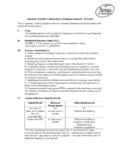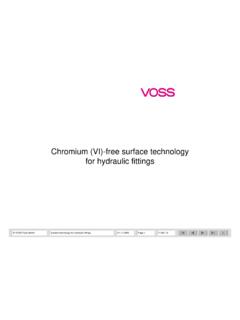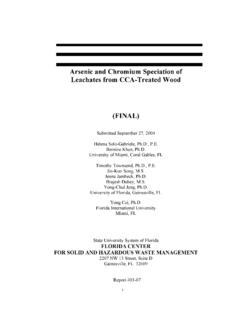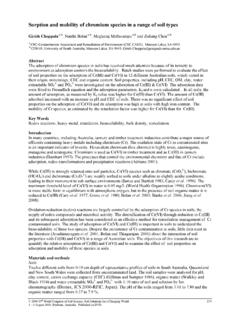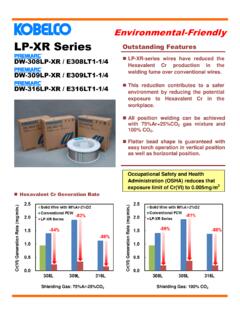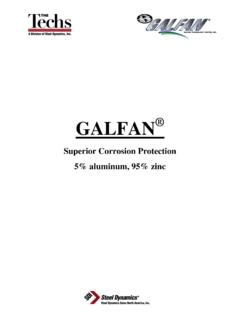Transcription of CHROMIUM, HEXAVALENT 7600
1 chromium , HEXAVALENT 7600. Cr(VI) MW: (Cr); (CrO3) CAS: 18540-29-9 RTECS: GB6262000. METHOD: 7600, Issue 2 EVALUATION: FULL Issue 1: 15 May 1989. Issue 2: 15 August 1994. OSHA : mg/m 3 (as CrO 3) PROPERTIES: oxidizing agent NIOSH: mg/m 3/10 h; carcinogen ACGIH: mg/m 3 (as Cr, soluble); some insoluble chromates are human carcinogens SYNONYMS: vary depending upon the compound SAMPLING MEASUREMENT. SAMPLER: FILTER TECHNIQUE: VISIBLE ABSORPTION. ( m PVC membrane) SPECTROPHOTOMETRY. FLOW RATE: 1 to 4 L/min ANALYTE: CrO 42--diphenylcarbazide complex VOL-MIN: 8 L @ mg/m 3. -MAX: 400 L EXTRACTION SOLUTION: N H 2SO 4 or 2% NaOH- 3% Na 2CO 3 (see steps 4 and 5). SHIPMENT: routine WAVELENGTH: 540 nm; 5-cm path length SAMPLE.
2 STABILITY: analyze within 2 weeks [1] CALIBRATION: standard solutions of K 2 CrO 4. in N H 2SO 4. FIELD BLANKS: 2 to 10 field blanks per set RANGE: to 7 g per sample ESTIMATED LOD: g per sample ACCURACY PRECISION (Sr): @ to g per sample [3]. RANGE STUDIED: to mg/m 3 [2]. (22-L samples). BIAS: - ): [2]. OVERALL PRECISION (SrT. ACCURACY: APPLICABILITY: The working range is to 5 mg/m 3 for a 200-L air sample. This method may be used for the determination of soluble Cr(VI) (using N H 2SO 4 as extraction solution or insoluble Cr(VI) (using 2% NaOH - 3% Na 2CO 3) [3]. INTERFERENCES: Possible interferences are iron, copper, nickel, and vanadium; 10 g of any of these causes an absorbance equivalent to about g Cr(VI) due to formation of colored complexes.)
3 Interference due to reducing agents ( , Fe, Fe ++ ). is minimized by alkaline extraction (step 5). OTHER METHODS: This method combines and replaces P&CAM 169 [1], S317 [2] and P&CAM 319 [3]; the Cr(VI) criteria document [4] contains a method similar to P&CAM 169. Method 7604 is also specific for HEXAVALENT chromium , using ion chromatography for measurement. NIOSH Manual of Analytical Methods (NMAM), Fourth Edition, 8/15/94. chromium , HEXAVALENT : METHOD 7600, Issue 2, dated 15 August 1994 - Page 2 of 4. REAGENTS: EQUIPMENT: 1. Sulfuric acid, conc. (98% w/w). 1. Sampler: polyvinyl chloride (PVC) filter, 2. Sulfuric acid, 6 N. Add 167 mL conc. H 2SO 4 m pore size, 37-mm diameter in to water in a 1-L flask; dilute to the mark.
4 Polystyrene cassette filter holder (FWSB. 3. Sulfuric acid, N. Add mL conc. [MSA] or VM-1 [Gelman] or equivalent). H2SO 4 to water in a 1-L flask; dilute to the NOTE: Some PVC filters promote reduction mark. of Cr(VI). Check each lot of filters for 4. Sodium carbonate, anhydrous. recovery of Cr(VI) standard. 5. Sodium hydroxide. 2. Personal sampling pump, 1 to 4 L/min, with 6. Potassium chromate. flexible connecting tubing. 7. Diphenylcarbazide solution. Dissolve 500 mg 3. Vials, scintillation, 20-mL glass, PTFE-lined sym-diphenylcarbazide in 100 mL acetone and screw cap.**. 100 mL water. 4. Forceps, plastic. 8. Cr(VI) standard, 1000 g/mL. Dissolve 5. Spectrophotometer, UV-visible (540 nm), with g K 2 CrO 4 in deionized water to make cuvettes, 5-cm path length.
5 1 L, or use commercially available solution.* 6. Filtration apparatus, vacuum.**. 9. Calibration stock solution, 10 g/mL. Dilute 7. Beakers, borosilicate, 50-mL.**. 1000 g/mL Cr(VI) standard 1:100 with 8. Watchglass.**. deionized water. 9. Volumetric flasks, 25-, 100- and 1000-mL.**. 10. Filter extraction solution, 2% NaOH-3% 10. Hotplate, 120 to 400 C. Na 2CO 3. Dissolve 20 g NaOH and 30 g 11. Micropipettes, 10- L to 1-mL. Na 2CO 3 in deionized water to make 1 L of 12. Centrifuge tubes, 40-mL, graduated, with solution. plastic stoppers.**. 11. Nitrogen, purified. 13. Buchner funnel.**. 14. Pipettes, TD 5 mL.**. * See SPECIAL PRECAUTIONS. ** Clean all glassware with 1:1 HNO 3 and rinse thoroughly before use.
6 SPECIAL PRECAUTIONS: Insoluble chromates are suspected human carcinogens [4]. All sample preparation should be performed in a hood. SAMPLING: 1. Calibrate the sampling pump with a representative sampler in line. 2. Sample at an accurately known flow rate in the range 1 to 4 L/min for a sample size of 8 to 400 L. Do not exceed 1 mg total dust loading on the filter. 3. Remove the filter from the cassette within 1 h of completion of sampling and place it in a vial to be shipped to the laboratory. Handle the filter only with forceps. Discard the backup pad. SAMPLE PREPARATION: NOTE: There are two sample preparation techniques outlined below. For soluble chromates or chromic acid, follow step 4; for insoluble chromate or Cr(VI) in the presence of Fe, Fe 2+.
7 Or other reducing agents, follow step 5. 4. Sample preparation for soluble chromates and chromic acid. a. Remove the blank and sample filters from the vials, then fold and place them into centrifuge tubes. b. Add 6 to 7 mL N H2SO 4 to each tube, cap, and shake to wash all surfaces of the filter. Allow filter to remain in tube 5 to 10 min [6]. c. Remove the filter from the tube with plastic forceps, carefully washing all surfaces with an NIOSH Manual of Analytical Methods (NMAM), Fourth Edition, 8/15/94. chromium , HEXAVALENT : METHOD 7600, Issue 2, dated 15 August 1994 - Page 3 of 4. additional 1 to 2 mL N H2SO 4. Discard the filters. Start reagent blanks at this point. d. Filter the solution through a moistened PVC filter in a Buchner funnel to remove interferences from suspended dust.
8 Collect the filtrate in a clean centrifuge tube. Rinse the bottle, which contained the filter, with 2 to 3 mL N H2SO 4 and pour into the funnel. Rinse the funnel and filter with 5 to 8 mL N H2SO 4. e. Add mL diphenylcarbazide solution to each centrifuge tube. Bring the total volume in each centrifuge tube to 25 mL with N H2SO 4. Shake to mix and allow color to develop (at least 2 min but no longer than 40 min. [6]). Transfer the solution to a clean 5-cm cuvette and analyze within 40 min of mixing (steps 9 through 11). 5. Sample preparation for insoluble chromates and for Cr(VI) in the presence of iron or other reducing agents: NOTE: If significant amounts of Cr(III) are expected to be present, degas the sample solution by bubbling nitrogen through it for 5 min.
9 Before proceeding and purge the headspace above the solution during step a. Remove the PVC filter from the bottle, place it in a 50-mL beaker, and add mL filter extraction solution, 2% NaOH/3% Na 2CO 3. Start reagent blanks at this point. Purge the headspace above the solution with nitrogen throughout the extraction process to avoid oxidation of any Cr(III). Cover the beaker with a watchglass and heat it to near the boiling point on a hotplate with occasional swirling for 30 to 45 min. Do not boil the solution or heat longer than 45 min. Do not allow the solution to evaporate to dryness because HEXAVALENT chromium may be lost owing to reaction with the PVC filter. An indication that HEXAVALENT chromium has been lost in this manner is a brown-colored PVC filter.
10 B. Cool the solution and transfer it quantitatively with distilled water rinses to a 25-mL. volumetric flask, keeping the total volume about 20 mL. NOTE: If the solution is cloudy, filter it through a PVC filter in a vacuum filtration apparatus using distilled water rinses. c. Add mL 6 N sulfuric acid to the volumetric flask and swirl to mix. CAUTION: CARBON DIOXIDE WILL BE EVOLVED CAUSING INCREASED PRESSURE. IN THE FLASK. LET THE SOLUTION STAND FOR SEVERAL MINUTES. UNTIL VIGOROUS GAS EVOLUTION CEASES. d. Add mL diphenylcarbazide solution, dilute to the mark with distilled water and invert several times to mix thoroughly. Pour out about one-half of the contents of the flask, stopper the flask and shake it vigorously several times, removing the stopper each time to relieve pressure.










